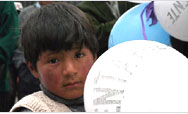Overview
USAID's Environmental Health Program
Environmental factors often play a role in death and disease among young children, especially the leading infectious diseases that affect children – acute respiratory infections, diarrhea, and malaria. Acute lower respiratory infections, mainly pneumonia, are the leading cause of death among children under age 5 and are closely associated with exposure to indoor smoke from cooking with biomass fuels. Diarrhea, another leading killer of children that accounts for 15 to 18 percent of child deaths annually, is largely caused by unsafe water, inadequate sanitation, and poor hygiene. Malaria, which is responsible for up to 2.5 million annual deaths, mostly among young children, has environmental dimensions as well. While combating malaria, USAID employs strict environmental guidelines, approval processes, and procedures for the use of DDT and all other World Health Organization-approved insecticides, ensuring their safe and judicious use.
In its environmental health programs, USAID aims to provide global leadership in developing, implementing, and promoting up-to-date interventions to prevent illness and death associated with environmental factors. About 1.6 million children under age 5 died last year from diarrheal diseases caused by unsafe water and poor sanitation in developing countries, and millions more were put at significant risk of exposure to water-borne infections, such as cholera, typhoid fever, and dysentery. Household-level or point-of-use (POU) chlorination is one approach that has been tested on a national scale and has a demonstrated public health impact on diarrhea at a low cost, allowing for wide coverage. USAID promotes two approaches to POU chlorination: the Safe Water System, developed by the U.S. Centers for Disease Control and Prevention (CDC), and PuR, developed by Procter and Gamble. These disinfection technologies have been shown to reduce disease and death by 35 to 50 percent. Below are links to information on current USAID-sponsored projects in environmental health, environmental health technical areas, and past environmental health projects supported by USAID.
Technical Areas
The links below provide an overview of the issues and USAID’s environmental health priorities:
Learn More
|


